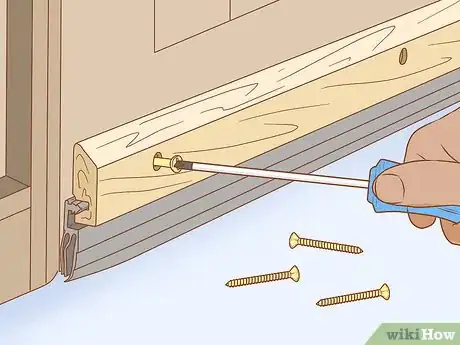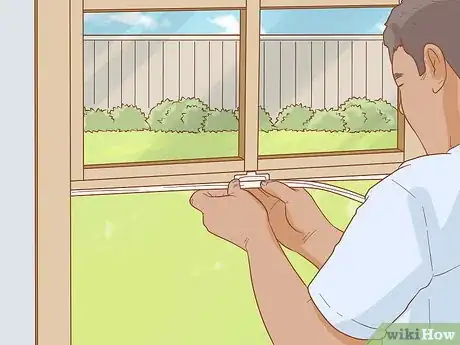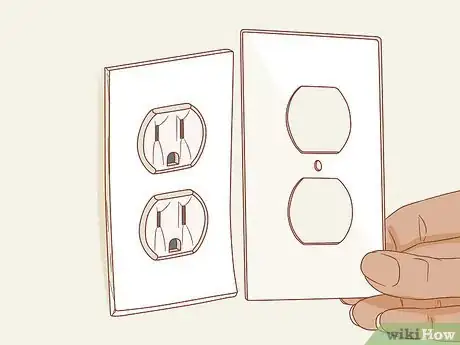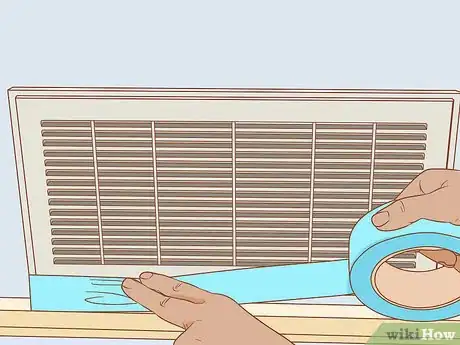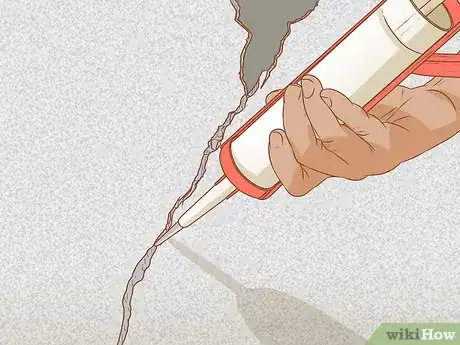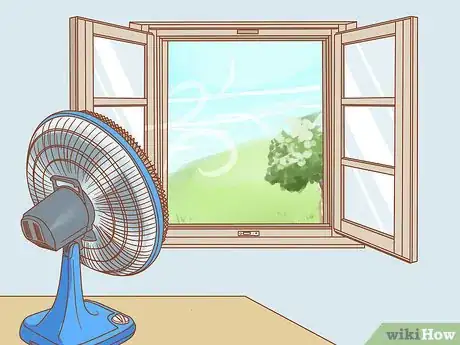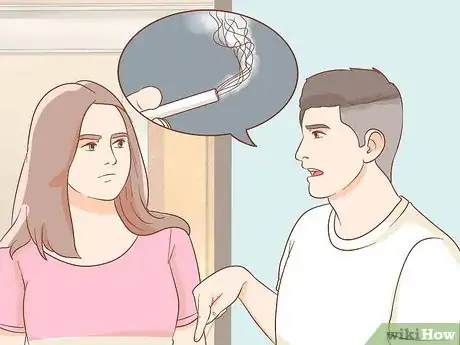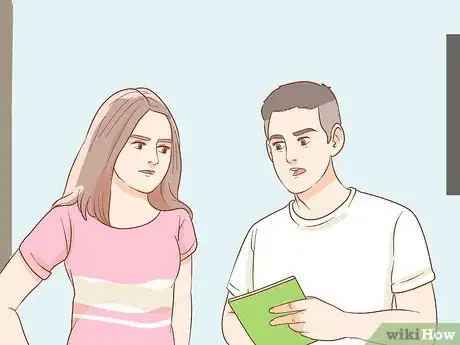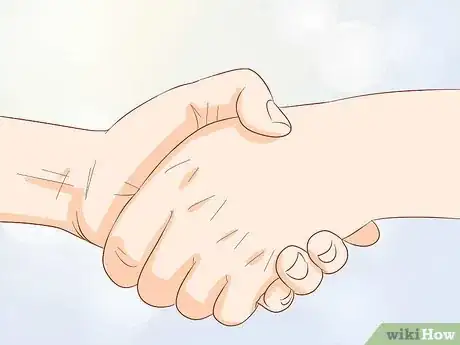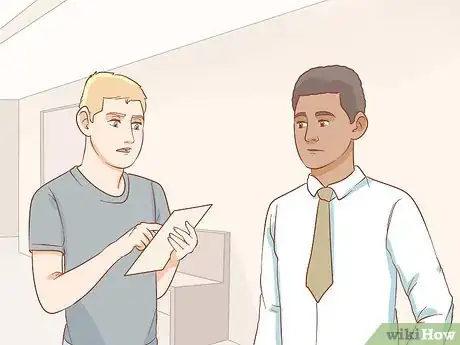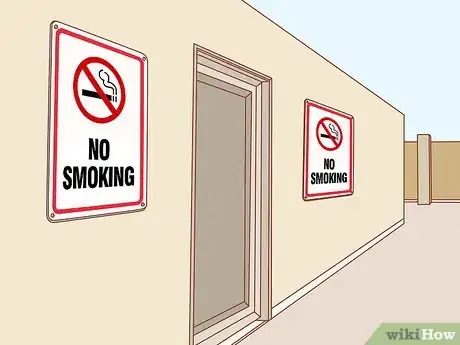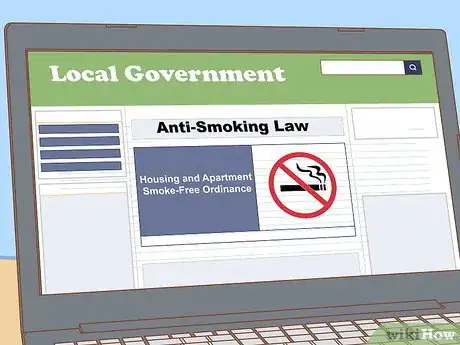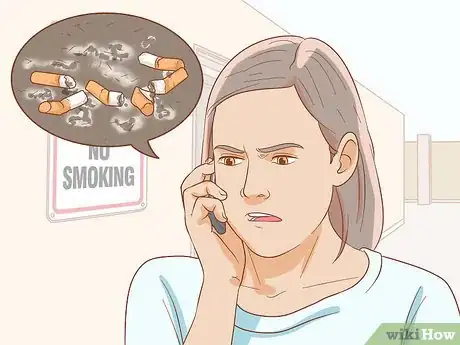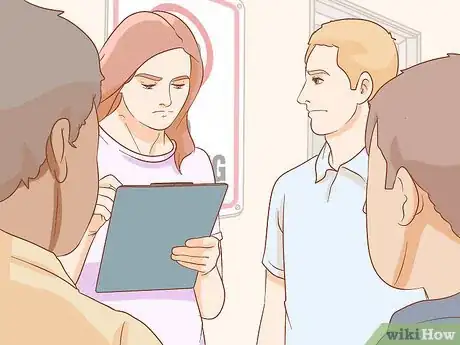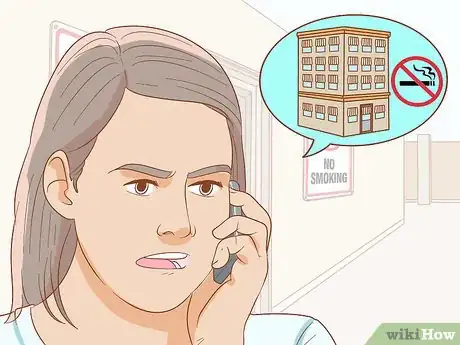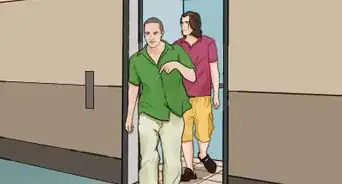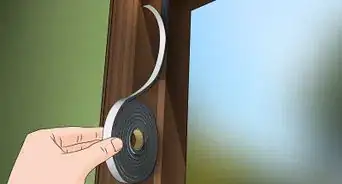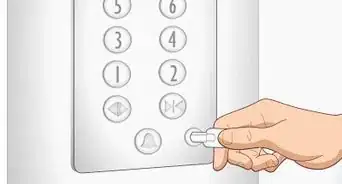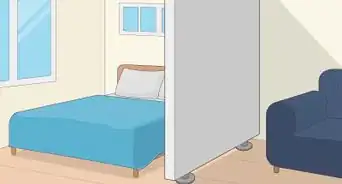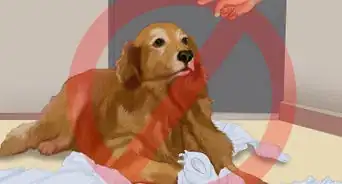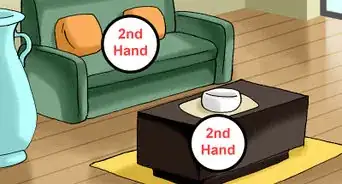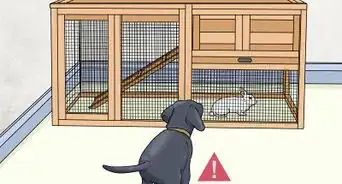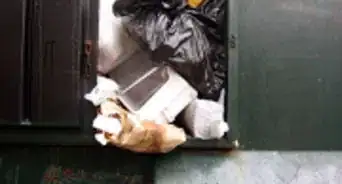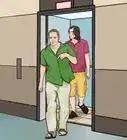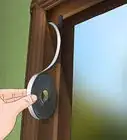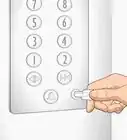This article was co-authored by wikiHow staff writer, Danielle Blinka, MA, MPA. Danielle Blinka is a Writer, Editor, Podcaster, Improv Performer, and Artist currently living in Houston, TX. She also has experience teaching English and writing to others. Danielle holds a Bachelor of Arts in English, Bachelor of Arts in Political Science, Master of Arts in English with a concentration in writing, and Master of Public Administration from Lamar University.
This article has been viewed 528,050 times.
Learn more...
Secondhand smoke can be harmful to you and your family, so you’re likely worried if it’s coming into your apartment. To completely stop the smoke from entering your apartment, your neighbor will need to stop smoking in the building. If you know which neighbor is smoking, try talking to them to see if they'd be willing to change their smoking habits. In the short-term, you can protect your family by sealing off your apartment. If that doesn’t work, contact your landlord to ask for their help.
Steps
Sealing Your Apartment
-
1Block the gaps under your door with a door sweep or draft guard. Smoke can easily drift into your apartment under your exterior door. You may be able to block it by installing a rubber door sweep at the bottom of your door. If you can’t alter the door, lay a draft guard or rolled up towel across the threshold to block the gap under the door.[1]
- Ask your landlord if they will install the door sweep.
- You can find draft guards at many home goods stores or online. You can also make one yourself by rolling up a towel.
-
2Apply weather stripping to windows to block outdoor smoke. Smoke may come in through your windows if one of your neighbors smokes on their balcony or patio. If this happens, keep your windows closed and install weather stripping to block the smoke from entering your apartment.
- If you're not permitted by your landlord to install weather stripping, you can block much of the smoke by tucking a rolled up towel around the bottom of the window.
Advertisement -
3Block your electrical sockets using plugs or seals. Unfortunately, smoke can come through your electrical sockets because apartments are all connected. You can limit how much smoke comes through by blocking the outlets. Use plugs or outlet seals to cover the socket. Push them into the socket and make sure the back of the plug is flush against the socket.[2]
- You can purchase seals made for electrical outlets and light switch points. Ask at your local hardware store.
-
4Use insulation padding and painter’s tape to block vents and large gaps. Smoke may also drift in through air vents or gaps around your heating or air conditioner. You may be able to block the smoke by covering the gaps with insulation padding or painter’s tape. Tuck the padding into the gaps or lay it over a vent. Then, use the painter’s tape to secure the padding in place.
- It’s best to talk to your landlord to find out if they can seal some of the gaps.
- Using padding and tape won’t alter the infrastructure of your apartment, so it won’t violate your lease.
-
5Apply caulk or tape to seal cracks and gaps in the wall. You may have cracks around vents, cable cords, electrical sockets, lighting fixtures, and windows. If your landlord allows it, use caulk to completely seal these cracks so smoke can’t enter through them. Hold the nozzle of the caulk gun flush with the crack, then squirt a thin layer of caulk into it. If you can’t use caulk, use painter’s tape to cover the gaps.
- Tape won’t work as well as caulk, but it’s better than nothing.
-
6Use a fan to blow the smoke out of your home if you have a window. Position your fan in the window or near it. Angle it so it’s blowing out of the window. Turn the fan on whenever you see or smell the smoke. The fan may pull the smoke out of your apartment and blow it outside.
- Fans don’t always work, but they can help.
- A large box fan is the best type of fan for this.
Warning: You’ll need to open your window to use a fan, so this might not be a great option for you if the smoke is coming from outside. In that case, it’s better to seal your window as best as you can.
Talking to Your Neighbor
-
1Talk to your neighbor if you know where the smoke is coming from. While you might be nervous, talking to your neighbor is often the best way to fix the problem. It’s likely that your neighbor doesn’t know their smoke is entering your apartment, and they may not even know it’s dangerous. Approach your neighbor in a calm, helpful manner to talk about the issue.[3]
- You might knock on the door and say, “Hi, I’m your neighbor Maggie. I was hoping I could talk to you for a few minutes.”
-
2Explain that the smoke is coming into your apartment. Tell your neighbor exactly what you’re experiencing, such as seeing visible smoke drifting through the vents, smelling smoke, or having health issues. Let them know that you and your family members are having trouble breathing because of the smoke.[4]
- You might say, “I’m sure you don’t realize this, but smoke is drifting from your apartment into mine. We can see it coming in through the vents and smell it in every room. It’s causing us to have trouble breathing.”
-
3Discuss the dangers of secondhand smoke. Don’t assume that your neighbor already knows that secondhand smoke is harmful. It’s possible that they think their habit isn’t hurting anyone. Show them a brochure or handout that explains how dangerous the smoke is. Then, let them know that you’re worried about how the smoke is affecting your family.
- Say something like, “I know it seems like the smoke is only affecting you, but we’re breathing it in, as well. Secondhand smoke might make my asthma worse and could cause serious health issues, like lung cancer. I’m worried that my family’s health is at risk.”
-
4Work with your neighbor to find a compromise. Tell your neighbor that you aren’t trying to control their behavior or stop them from smoking. Then, ask them if they’d be willing to make changes so that the smoke won’t come into your apartment. Bring a list of suggestions, but be open to their ideas, as well.[5]
- You might say, “I’m not here to tell you what to do or try to stop you from smoking. I just wanted to find a way for you to continue doing what you like without the smoke coming into my apartment. Can we talk about a compromise?”
Here are some suggestions you might make:
They could smoke outdoors instead of inside.
They can block their doors, windows, and vents to prevent smoke from escaping.
They can use a fan to blow the smoke out of the window while they’re smoking.
They can avoid smoking in hallways and common areas.
-
5Take the issue to your landlord if your neighbor refuses to change. You might feel defeated if your neighbor keeps polluting your home with smoke, but you still have options. Your landlord may be willing to help you, and your city or county may have laws that protect you. If the problem persists, it's time to contact your landlord.
Contacting Your Landlord
-
1Check if smoking is allowed in your lease, then contact your landlord. Many landlords ban smoking because it protects the health of their tenants and keeps their property clean. Read over your lease to find out if that’s the case for you. If it is, contact your landlord to let them know that your neighbor is violating the no-smoking policy.[6]
- Say, “I have smoke drifting into my apartment from apartment 212. Is there something you could do about that?”
-
2Review the laws in your area to see if smoking in housing units is illegal. Your local government may have laws or ordinances that require landlords to either notify you of smoking in the apartment complex before you sign a lease or protect you from secondhand smoke. Look up the laws in your area to find out if they apply to your situation. Then, use this information when you talk to your landlord.[7]
- Check your city’s or county’s website to find out if there’s a law in place. You might also do an Internet search.
- See if your area has a tenant's rights organization that can help you learn more about your rights.
-
3Document how the secondhand smoke affects you and your family. Keep detailed notes so you have a record of what you’re experiencing. Write down dates, what happened, and how you feel. Additionally, keep track of how many times you go to the doctor because of the smoke. This will help you prove that the smoke is causing you harm.
- Note how many times a day you smell the smoke.
- Describe what you’re experiencing.
- Explain which rooms of your home are affected and how.
- Take pictures of smoke plumes or cigarette butts.
- Write down how the smoke makes you or your family feel.
Tip: See a doctor if the smoke is triggering your asthma, allergies, or other health conditions. Get documentation from your doctor to prove that you have a medical need to live in a smoke-free environment.
-
4Contact your landlord to ask them for help. You likely feel nervous about talking to your landlord, but try not to be scared. Instead, start your conversation by reminding them that the secondhand smoke is affecting their property. Then, let them know about the problems you’ve been having and how your family is affected by the smoke.[8]
- You might say, “Since the smoke is throughout the building, I’m sure you’re worried about cleanup costs and property damage. Additionally, my family is having trouble breathing, and my daughter now has asthma. We’re hoping that you might be willing to go smoke-free so that the entire building is cleaner.”
- Keep a record of all of your communications with your landlord in case you need them to prove that you’ve tried to seek help from them.
-
5Invite your other non-smoking neighbors to attend a landlord meeting. You might feel alone, but it’s likely you have fellow neighbors who are upset about the smoke. If you all approach your landlord together, you might be able to convince them to take action. Talk to your neighbors to see if they’d be willing to speak up. Then, ask them to talk to your landlord with you.
- Say, “Hi, I’m Maggie from apartment 214. Have you noticed any smoke coming into your apartment? I’m going to be talking to the landlord about it and hoped you’d be open to joining me.”
Variation: Start a petition to make your apartment building completely smoke free, and ask your neighbors to sign it. Then, give the petition to your landlord.
-
6Contact county code enforcement if your landlord is violating the law. If your landlord is required by law to address the secondhand smoke but refuses to do so, county code enforcement officials may be able to issue a citation. Call your local code enforcement to find out how to file a claim. Then, report your landlord for not complying with local codes.
- If your area doesn’t have code enforcement, call your city council official, mayor’s office, city manager’s office, or the law enforcement non-emergency line. They can advise you on who to contact about this issue.
-
7Consider a lawsuit if nothing else helps. You can sue your landlord to force them to address the secondhand smoke, and you might sue your neighbor for damages. However, it’s often expensive and difficult to pursue a lawsuit, so it’s best to only do it if you have no other options. If you think a lawsuit is right for you, talk to a lawyer to find out if you have a case.
- You’ll need to prove that secondhand smoke is harming you, so make sure you have good documentation about what’s been happening. Additionally, it’s best to have medical records that show you’re being treated for conditions related to the smoke.
Warnings
- Don’t try to do any major repairs on your apartment without written permission from your landlord. Your lease likely limits what kind of work you can do.⧼thumbs_response⧽
- Be aware that ventilation systems and portable air cleaners do not adequately filter smoke particles. They can reduce the odor, but the harmful smoke particles will still be present in the air.⧼thumbs_response⧽
- Secondhand smoke is dangerous to every person exposed to it. Chemicals from smoke, such as benzene, settle on your upholstery, walls, food, bed, and personal items.[9]⧼thumbs_response⧽
References
- ↑ https://dphhs.mt.gov/publichealth/mtupp/SFH
- ↑ https://dphhs.mt.gov/publichealth/mtupp/SFH
- ↑ https://www.lung.org/our-initiatives/tobacco/smokefree-environments/multi-unit-housing/secondhand-smoke.html
- ↑ https://sonomacounty.ca.gov/Health/Public-Health/Healthy-Communities/Tobacco-Prevention/Compliance/Renters-and-Landlords/Guidelines-for-Tenants-Drifting-Smoke/
- ↑ https://www.lung.org/our-initiatives/tobacco/smokefree-environments/multi-unit-housing/secondhand-smoke.html
- ↑ https://www.lung.org/our-initiatives/tobacco/smokefree-environments/multi-unit-housing/secondhand-smoke.html
- ↑ https://www.lung.org/our-initiatives/tobacco/smokefree-environments/multi-unit-housing/secondhand-smoke.html
- ↑ https://www.lung.org/our-initiatives/tobacco/smokefree-environments/multi-unit-housing/secondhand-smoke.html
- ↑ https://www.cdc.gov/tobacco/campaign/tips/quit-smoking/guide/secondhand-smoke.html
About This Article
To stop secondhand smoke from coming into your apartment, place a fan near your window to direct the smoke out of the room. If smoke is coming from your air vents or large gaps around them, use painter’s tape to block the holes. If you know which neighbor the smoke is coming from, politely ask them if there’s any way they can direct their smoke away from your apartment. You can also mention that you’re concerned about the dangers of secondhand smoke. If your neighbors are unwilling to compromise with you, contact your landlord so they can help you resolve the situation. For more tips, including how to seal your doors and windows to block secondhand smoke, read on!
